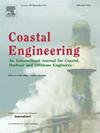Statistical design of submerged artificial oyster reefs using Design of Experiments and clustering strategies
IF 4.5
2区 工程技术
Q1 ENGINEERING, CIVIL
引用次数: 0
Abstract
The implementation of artificial oyster reefs as a Nature-based Solution to enhance ecological benefits and shoreline protection represents a prominent area of research. Nevertheless, the wave attenuation performance of multiple underwater artificial reefs has yet to be subjected to comprehensive investigation. To address this gap, we investigated numerically the wave attenuation produced by a sequence of submerged artificial oyster reefs, taking into account a range of incoming wave conditions and configurations of the artificial reefs themselves. A large number of simulations have been designed using an approach based on the Design of Experiment theory, namely the D-optimal approach. The large dataset obtained has been analyzed using unsupervised machine learning techniques, i.e. the weighted K-means. The results showed a clear separation of the combinations of physical variables that led to the lowest transmission coefficients. In particular, three dimensionless variables were identified as being of particular significance for minimizing the transmission coefficient, namely the submergence of the oyster reefs, the length of the oyster reef in relation to the incident wavenumber, and the number of oyster reefs. Relative water depth, wave steepness, distance between adjacent oyster reefs, and seabed slope were found to play a minor role. Based on the results, we suggested an optimal statistical design strategy in order to reach a wave transmission coefficient as low as 0.5, provided the specific characteristic of the site (design wave, slope of the shoaling zone, and water depth). These findings will provide guidance for practical application.
基于实验设计和聚类策略的水下人工牡蛎礁统计设计
实施人工牡蛎礁作为一种基于自然的解决方案,以提高生态效益和保护海岸线是一个突出的研究领域。然而,多种水下人工鱼礁的消波性能尚未得到全面的研究。为了解决这一差距,我们在数值上研究了一系列水下人工牡蛎礁产生的波衰减,同时考虑了一系列入射波的条件和人工礁本身的配置。基于实验设计理论,即d -最优方法,已经设计了大量的仿真。获得的大型数据集使用无监督机器学习技术进行分析,即加权k均值。结果表明,导致最低透射系数的物理变量组合的明显分离。其中,确定了三个无量纲变量,即牡蛎礁的淹没度、牡蛎礁相对于入射波数的长度和牡蛎礁的数量,对最小化透射系数具有特别重要的意义。相对水深、波浪陡度、邻近牡蛎礁之间的距离和海底坡度的影响较小。在此基础上,根据场地的具体特征(设计波、浅水区坡度和水深),提出了最优的统计设计策略,以使波浪透射系数低至0.5。这些发现将为实际应用提供指导。
本文章由计算机程序翻译,如有差异,请以英文原文为准。
求助全文
约1分钟内获得全文
求助全文
来源期刊

Coastal Engineering
工程技术-工程:大洋
CiteScore
9.20
自引率
13.60%
发文量
0
审稿时长
3.5 months
期刊介绍:
Coastal Engineering is an international medium for coastal engineers and scientists. Combining practical applications with modern technological and scientific approaches, such as mathematical and numerical modelling, laboratory and field observations and experiments, it publishes fundamental studies as well as case studies on the following aspects of coastal, harbour and offshore engineering: waves, currents and sediment transport; coastal, estuarine and offshore morphology; technical and functional design of coastal and harbour structures; morphological and environmental impact of coastal, harbour and offshore structures.
 求助内容:
求助内容: 应助结果提醒方式:
应助结果提醒方式:


